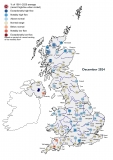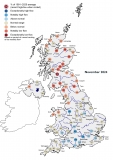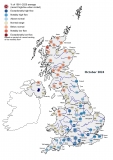Definition
The Peaks Over Threshold (POT) series contains all peak flows that are greater than a given threshold flow, the threshold is generally set to include an average of 5 events per year. Where multiple peak flows occur in a single event, the largest is used for the POT series (See FEH Volume 3, section 23.5.1).
Data Sources
The source of each POT value is given in the POT table. Recent years have been extracted directly from digital archives. The main sources for early years are the FEH / CEH dataset, the Hydpeaks archives in EA Thames region and the University of Dundee in Scotland. In Northern Ireland, POTs have been manually extracted as part of the Department for Infrastructure - Rivers procedures.
Digital Archives
POT values have been extracted from digital archives wherever possible, using the extraction criteria outlined in FEH Volume 3, section 23.5.1 (page 275). The procedure described in the FEH is suitable for automatic data extraction followed by inspection to remove any remaining erroneous peaks. However, for the entire automated process used here, the FEH independence criteria of the trough between two peaks having to be less than 2/3 of the magnitude of the first of the two peaks were modified. The new criteria state that the trough has to be less than 2/3 of the magnitude of both peaks, to take into account minor blips on the recession limb (such as might occur due to a small amount of rain at the end of long recession limb).
Non-digital Archives
The FEH / CEH dataset was derived for the Flood Studies Report of 1975. It is used where other data are not available or are considered less reliable. Much time and effort was spent in extracting these data and the record is generally considered to be good. The FEH .pt files only present flow data, which may mean that the whole data series is not consistent where rating curved have been changed significantly after re-analysis. However, for the majority of stations, the levels were also available in paper format and this data has been added so that the whole data series can be re-processed to give a consistent flow record, whatever the changes in rating. The average number of events is lower than applied in the digital record extraction process, and this may mean that there appear to be gaps in the early record when it is in fact continuous.
There may be discrepancies where more than one source has been used to extract POT data, particularly where one source has used calendar days and another water days, possibly with an unknown time set to 00:00. This can be seen in a duplication of data between the data sources, as is shown in the example below. Such duplicate values have been removed where identified.
| Date | Time | Stage | Flow | Rating | Source | Ref |
|---|---|---|---|---|---|---|
| 01/12/1975 | 00:00 | 1.180 | 14.93 | In Range | FSR | 1a |
| 02/12/1975 | 04:30 | 1.185 | 15.03 | In Range | Mfiche | 1a |
The Hydpeak archives in EA Thames region store the peak level and flow in each month. Therefore, where there are two or more peaks in the same month, only the largest is extracted to the POT record.
Post-processing
Different sources may have extracted POT data by different methods, and a series might have been extracted using different thresholds at different times. In many cases, this gives fewer POT values in each year in the earlier non-digital record than in the digital record. Wherever possible, the same threshold has been imposed on the whole dataset. The digital extraction threshold is often low (to get 10 to 12 peak per year), but for the data given in the POT files and on the website, the threshold has been set to be the highest used through the period of record (digital and pre-digital), as long as this gives 3 to 5 peaks per year. This series was then adjusted by eye to give some consistency for the whole period of record.
Stations without POT data
Some stations have no POT data or .pt file because they have been considered to be unsuitable for POT extraction. This is usually because the gauged catchment response does not lend itself to POT analysis. Such rivers are usually dominated by baseflow and are therefore concentrated on the large chalk aquifers of southern and eastern England.
A list of useful definitions is provided as part of the NRFA Glossary here.



